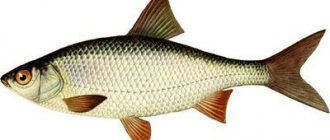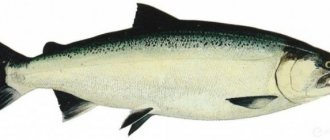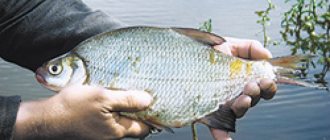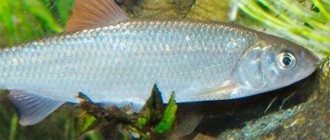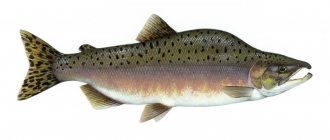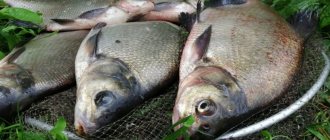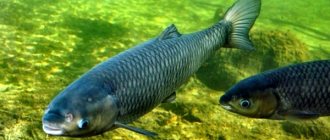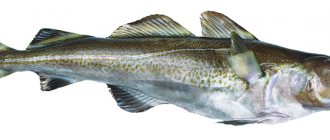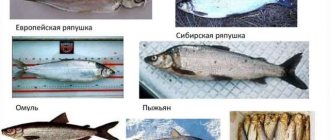External differences between silver bream and bream
Two species of fish belong to the Cyprinidae family. An adult silver bream is similar to a young bream in color, body shape, and habitat. The height of their bodies is one third of their length. The color of their bodies, flattened laterally, is usually silver-gray. The silver bream has scales with a blue tint. During breeding, white spots appear on the surface of the carcass of males, and the fins of females turn pinkish or scarlet.
The silver bream rarely reaches its maximum weight; the average size is about half a kilogram. It is slightly thinner and more bony compared to the bream, which is comparable in length.
Length 35 cm and weight 1.3 kg for silver bream are maximum. Bream reaches similar parameters at a young age. The length of the largest specimen is 82 cm and weighs 6 kg. The bream is a young and small individual. The color of a bream's scales is affected by its age and habitat. The body of a sexually mature individual is painted golden.
The average weight of bream in reservoirs is 1–2 kg. Sometimes it is possible to catch specimens weighing 3–4 kg. A fish with a pointed head is distinguished by its gaze, which is directed towards the bottom. The diameter of the eye is usually smaller compared to the length of the nose. The mouth opening is converted into a tube as needed. The bream is distinguished by an elongated anal fin originating on the back.
The differences between the fish are shown in the table:
- along the side contour
- across the body.
- 51-57
- 12-18
- 44-50
- 13
Description of the species
Despite the uniqueness of the genus, there are different species groups of fish, which are determined by their prevalence and habitat. The most famous include common, Danube, eastern and Volga bream. All of them have a strongly laterally compressed rounded body, which is characterized by an abnormal height of 1/3 of the length of the body. The main differences are color and size.
The standard is officially considered to be the large common bream, which is characterized by:
- sides of brown, brown or golden shades;
- fins are gray with a dark border;
- yellowish belly;
- a compact head with large eyes and a small retractable mouth-tube for sucking in small-sized plant food, which clearly answers the question of whether the bream is a predator or not.
- scaleless keel between ventral and anal fins.
Juveniles can differ significantly in color from larger bream and are often completely silver in color. The short and high dorsal fin is noticeably displaced towards the tail and has three hard and about ten soft rays. The long anal fin also has several spines and a large number of less rigid rays (22-29 pieces).
To learn more:
What does the predatory fish pike bite on?
The average weight of fish varies between 1.5-3 kg. More massive individuals with a length of 30-45 cm are considered trophy. The maximum weight is 6-7 kg. But there are exceptions.
Officially, the largest bream in the world has broken the 11.5 kg mark. This giant was caught in the Finnish Lake Vesijärvi back in 1912.
If you do not take into account official statistics and refer to the records of domestic zoologists, you can find out that the largest bream caught in Russia weighed more than 16 kg. The reservoirs of the Vitebsk province (Pskov and Smolensk regions) were once famous for such giants.
White bream fish
The largest population of bream is represented by immature young animals up to three years old and weighing 300-700 g, which are distributed in all reservoirs of Russia, with the exception of rivers with too fast a flow or a rocky bottom. Historical confusion has led to the fact that the fish, which is similar to bream and is in fact one, received its own name - bream.
Many inexperienced fishermen are sure that bream and bream are different species, and try to find differences between them, which, of course, exist, but disappear with age. In addition to their smaller size and weight, the difference between the white bream and the bream is visible in the elongated body and silvery-white color of the former. A more difficult task is to find the differences between young bream and silver bream. This is another unique representative of the cyprinid family from the class of ray-finned fish, which alone forms the monotypic genus Blicca.
Gustera: similarities and differences from young bream
Fishing for bream on lakes and rivers in many parts of Russia often gives quite interesting results. The cage may contain identical fish in appearance with minimal differences in color. Some have pectoral and pelvic fins with a red or pink base and a gray tip, while others have a solid dark gray color, sometimes with a black border. It is the reddish-pinkish fins that are the first clue to the question of how to distinguish a silver bream from a bream.
To learn more:
Burbot: what kind of fish is this?
The silver bream is not a large fish; it rarely grows to weigh more than 600-800 grams and remains a desirable trophy for pike, pike perch, and large perch all its life. That is why in reservoirs with an abundance of predators it has to become as invisible as possible, which leads to the disappearance of the red tint of the fins. And then the external resemblance to young bream becomes phenomenal.
White bream at spawning
But regardless of the habitat, the physiological differences between the silver bream and the white bream, originally laid down by nature, are always preserved:
- a flatter and laterally compressed body, which gave rise to the appearance of local names for the fish: flatfish, plywood, flatfish;
- proportionally larger eye size in relation to the size of the head;
- equal length of both tail fin feathers;
- larger scales.
The last sign is the main one and allows you to accurately distinguish between the silver bream and the white bream. In young bream, the number of rows of scales from the lateral line to the first ray of the dorsal fin is 14 or more. The silver bream has 10-12 rows. Just a little time and fishing experience is enough for this difference to be quickly determined by eye.
Lifestyle
Small groups of bream swim in the immediate vicinity of the muddy, sandy or clayey bottom of the reservoir, away from the shore. The school swims to accumulations of algae at night to feed. Occasionally, fish leave the bottom and are caught near the shore. Bream move to the feeding site in schools, choosing the same path. The species is distinguished by its intelligence, caution, pickiness in food, and excellent sense of smell. Acceptable water temperature for intensive nutrition is +15. +20°C.
Elongated lips help to search for food: after taking a mouthful of liquid, it throws it into the mud with a powerful stream. This technique allows you to collect larvae. As a result of such activity, small bubbles form on the surface of the water surface along the path of fish movement.
Food for both species of cyprinids are:
- worms;
- aquatic insect larvae, such as bloodworms;
- small crustaceans;
- young algae shoots;
- slugs, snails
Spawning lasts 30 days. This process is accompanied by a loud splash. The larvae appear after 8–10 days and feed on zooplankton, attaching to algae using a special secretion. They remain in this state until all the yolk is used. The fry, 30 mm long, feed on benthos - organisms that live at the bottom of the reservoir. If you scare a bream, it will leave the spawning site. Cold weather slows down reproduction.
After laying eggs, representatives of the bream continue to protect their offspring for some time, and then go into the depressions where they permanently live. 7–14 days after breeding, an intensive search for food begins. This process starts in early June and lasts for 30–60 days.
Taste characteristics
The fleshy flesh of large specimens of silver bream is sweeter than bream fillet. Sun-dried, fried, boiled, dried fish has a pleasant, rich taste. It is baked, covered with foil. This preserves most of the beneficial substances of white, fairly high-calorie meat. The fish is easy to clean thanks to its large scales.
Despite the many bones, the meat of both types of fish contains a lot of protein, which is almost completely absorbed by the human body. It is advisable to include these protein products of animal origin in the diet of children, the elderly, and during physical labor.
Differences in fishing
Before breeding begins and when temperatures drop in the autumn months, representatives of cyprinids bite well on bloodworms and worms during the light period. A week or two after breeding, they are caught for one to two months. It is good to fish in the evening and at night using bait from maggots, bread, semolina or millet cereals, steamed pearl barley and oatmeal. Representatives of the silver bream are able to drive away and outstrip the largest bream.
With the beginning of winter, the best period for catching cyprinids is the first 14–21 days after freeze-up. For bait, small bloodworms, worms, and ground dry bread are used.
During the process, a little fresh bait is regularly added to the water. Watch the bait on the hook. It should be fresh, the porridge balls should be small. Without bait, bream can only be caught by accident.
To catch both types of fish, summer float and bottom fishing rods are used. A hook No. 3.5–5 with a short shank is suitable for this purpose. For a summer float fishing rod, use a fishing line with a thickness of 0.2–0.3 mm. In winter, a jig is additionally used. The float rod is equipped with a fishing line 0.15–0.2 mm thick.
In summer, it is better to fish for bream on strong, flexible tackle with elongated floats, hooks No. 4–7 with a short shank, which allows you to cast baits far, because in shallow water it does not swim close to the boat or the coastline.
The sinker-pellet on the fishing line of the float fishing rod is placed 3–5 cm from the hook. If you make a greater distance, the fish will not notice the bite. As soon as the float lies on the water, they immediately make a weak hook so as not to damage the lips, bring the individual to the surface, where it swallows air, weakens, turns over on its side and easily walks to the shoreline.
The silver bream is characterized by sharpness when biting: the float instantly disappears under the water surface. Very rarely does a fish behave differently. For example, it sluggishly lowers or, conversely, slightly raises the float and moves it to the side. When using a jig, the nod first drops slightly downwards, then sharply goes up.
These moments cannot be missed - cutting is needed. The fish is bold because it swims close to the boat to feed. To determine the presence of bream, it is worth observing the water surface. In the morning and evening, immediately after prolonged inclement weather or before a thunderstorm, it emerges silently - first the head appears, then the dorsal fin. Then it disappears to the bottom, leaving a diverging circle on the water.
According to the stories of fishermen, in the very hot summer period, when the amount of oxygen in the water is reduced, even the most “experienced”, well-fed breams rise closer to the surface of the reservoir, which cannot be caught with any tackle, but at this time the chances of catching increase.
It is advisable for future fishermen to know the basic characteristics of fish in order to distinguish them without errors. This is not an easy task because they:
- love thickets and bottom areas of reservoirs;
- lazy, calm, prefer to swim in schools;
- similar in appearance.
Head of the clan (bream, chebak)
More than once I have seen and heard crucian carp, carp, and roach frolicking in the coastal grasses during spawning... But what I happened to observe in the bay of the Kuchugury tract, on the shores of the Tsimlyansk Sea, left the impression of an extraordinary spectacle for a lifetime. Together with the village resident Viktor Losev, we went on a motor boat to help a team of fishermen set up nets for the night: a massive bream catch had begun. In the evening, when we, tired and exhausted from the unusual task, sat down by the smoldering fire, intending to taste the triple fish soup, a bream fight began in a quiet bay... It is impossible to describe this picture - you have to see it with your own eyes. Bream, two or three kilograms strong, flew out of the water with strong jerks and, flashing their silver sides in the fading rays of the evening dawn, splashed flat and loudly into the water. Before the splashes raised by one fish had time to fall onto the surface of the water, another bream immediately flew into the air... - They caress this, - Azhnik warms his soul. The head of the clan is frolicking: there will be a fruitful year... “They caress” is a very precise word; apparently the name of the fish itself came from it - bream, bream. (In Slovakia - pleskach). Small bream on the Don was called scavenger, or keel. Bream, or chebak, is a very important commercial fish in the Sea of Azov and the Don. Its largest catches were recorded about seventy years ago - over four hundred and sixty thousand centners per year. Now production has fallen sharply and at the end of the last century barely reached some forty to fifty thousand centners. Sea bream these days is mainly found in the Taganrog Bay. The Don begins to enter in the fall. In spring, bream starts spawning very early, right under the ice, and goes until June. Unlike pike perch, sturgeon and catfish, which move in the evening and at night, schools of bream move mainly in the morning. Its largest spawning grounds are the Don fields, but it also spawns in the Don delta, at the mouth of the Mius, and enters the Ust-Manych reservoir. At spawning grounds, males can be easily distinguished from females by their size and the presence of pearls on their heads and sides. One female can lay up to three hundred thousand eggs, which adhere to flooded vegetation. After a few days the larvae hatch. The active migration of juveniles into the sea lasts from June to August. Under favorable conditions, the fry reach six hundred grams by the age of five.
Semi-anadromous bream can live twelve to fourteen years, but due to excessive fishing, it usually does not reach “old age”. On one of my trips to Finland, in a conversation with local fishermen in Turku, I learned that in the lakes there the life expectancy of bream is twenty-two to twenty-seven years. By the way, in Finland, in literally every town, right in the center, there are temporary (from early morning until eleven in the afternoon) fish markets, where you can always buy live fish. Here you will find bream, pike, and pike perch... At the end of the trade, the tables and counters are cleared, the area is swept - and there are no traces of the market. And in the morning everything will repeat all over again... A funny observation: bream often does not look like... Amateur fishing for it is an interesting, but also difficult activity. In one reservoir, bream constantly lives in thickets of plants and feeds only at night, in another it strictly adheres to the edge of the vegetation and feeds only in the morning and evening dawns, in the third it prefers deep holes near the rubble of snags, steep banks, rocky and sandy shallows... At depths can feed and take the bait all day, in shallow water it will play near the surface, stick out its muzzle and tease the fisherman, or quietly make circles and not touch the bait at all... Bream is a very cautious, timid and intelligent fish. During spawning, even with little noise, a herd of chebaks can leave their favorite place and not return back even after the onset of silence. On the other hand, it is a sluggish, lazy fish, its movements are slow and heavy, it mostly stays at the very bottom of quiet and shallow waters. Bream actively swim during spawning, sometimes before a thunderstorm or in the midday heat, going out onto the shallows. Semi-anadromous and freshwater, or local, bream are found on the Don. The first lives in the Sea of Azov, although due to the increase in its salinity, it now most often stays in the Taganrog Bay, where the water is fresher. Well, the local one is so named because it lives in certain bodies of water: rivers, lakes, canals, estuaries... Bream loves to bask in the warmth, which is why it is not found in mountain rivers and reservoirs, where there is a fast current and cold water. It also does not accept heavily overgrown and salty lakes. Even in the eastern part of the Proletarsky Reservoir, where water mineralization is higher than in the rest of the area, the chebak does not appear, although in other areas it feels like a completely rightful owner. The tuvod chebak has become well established in such reservoirs as Tsimlyanskoye, Manychskoye, Yegorlytskoye, and the lower reaches of the Seversky Donets, although here dams still hinder it. Azov bream used to come to spawn in the floodplain surroundings of the Don, Manych, Sal... But now there are no floods and the living space of the head of the bream family has been greatly reduced, although scientists and practitioners are trying to restore the population.
...In the morning, the fishermen returned from the sea and brought bream. In the sapetkas woven from red talon there were still living chebaks: smaller, young, grayish-white, the color of tarnishing silver; slightly larger fish had a slightly different outfit - darker, brownish-black with a golden-yellow tint; In keelfish, or underbreeders, about seven hundred grams each, the fins are completely dark, and in the largest, the silver turned into a platinum color with a pink tint under the throat and on the belly; the record holders had golden scales, and they themselves had dark, blurry saddle cloths on their backs... Georgy GUBANOV. In the depths and in the shallows. Rostov-on-Don, 2012
It was interesting? Say thank you by clicking on the "Share" button and tell your friends:
Number of views: 8692
olenalex Sun, 16/11/2014 — 10:43
- Gubanov Georgy
- Don
- Bream
- Fish
- Fishing
- Login or register to post comments
By what signs can you distinguish bream from silver bream?
Silver bream and bream (bream) are two fish that novice fishermen always confuse. In fact, the two species are incredibly similar to each other, so it may not be immediately clear who is who. Despite the fact that these are different fish, they both belong to the carp family. In addition, both bream and silver bream live in the same reservoirs; they have approximately the same size, as well as the color of their scales.
The surprising thing is that the silver bream can adapt to the conditions in which it lives, and this additionally affects its resemblance to the white bream. If two individuals live in the same river, then even an experienced fisherman can find it difficult to understand how one fish differs from the other.
In order to distinguish silver bream from bream, it is necessary to carefully study these two species of waterfowl.
Gustera is a close relative of bream
White bream is a fish belonging to the carp family. It reaches a length of about 35 centimeters, and its weight can reach up to 1.3 kilograms, but most often representatives of the species weigh 100-200 grams. This fish leads a schooling lifestyle.
The silver bream is closely related to bream. She has the same laterally compressed body and silvery color as a young bream.
The difference between these fish is only in the location and number of pharyngeal teeth. The silver bream has not 5, but 7 teeth on each side, and they are arranged in two rows.
White bream and silver bream: what are they?
A young specimen of bream, which is familiar to all fishermen, is called a bream. The color of this species directly depends on the age of the fish, as well as its habitat. Young breams often have gray-silver scales, which change to golden in color with age. Bream can usually be found in the thickets, it stays with its “brethren” in a small flock. Fishermen note that these fish species are quite careful and intelligent.
In winter, the bream can be found in deep water, in various depressions and crevices.
The difference between the silver bream is, first of all, that it is more difficult to find in reservoirs, because it is less common in them. This is not a “loner” fish, so the presented subspecies always swim in large schools.
Gustera is always more active in feeding. At the same time, sometimes you cannot lure bream even with the most “appetizing delicacies”. With age, the scales of the silver bream do not change their color, remaining bright gray.
Important! Considering that the two species of fish described above have almost the same body shape and scales, they can be found in the same rivers, it will not be difficult to confuse them.
Although there is still a difference, it is not significant, but it is there.
Differences in fin shape and color
The main differences between silver bream and bream are their fins.
Guster has them like this:
- 3 ordinary rays in the dorsal fin, as well as 8 branched ones.
- 3 simple fins in the anal fin and about 20-24 branched ones.
As for the color of the fins, it is bright red. Actually, this is one of the clear signs that the fisherman is looking at the species of fish presented, and not some other. If we talk about unpaired fins, they are gray.
The bream's fins are:
- Gray in color and become darker over time.
- The anal fin (which starts from the dorsal fin) has about thirty rays.
Other Important Points
Bream and bream are considered one of the most common fish that many anglers “hunt”. The main feature is that this subspecies can be found in almost any river. Given the special taste of fish, it is served in many expensive restaurants, baked over coals, in the oven, steamed, etc. Dried bream is in particular demand. The fish meat is tender and lean, which cannot be said about the silver bream. This variety’s fillet is fattier and also richer, and the larger the individual, the more clearly this is felt.
How to quickly and accurately distinguish a silver bream from a white bream, so that the fish inspector does not deceive
For novice fishermen, it is sometimes difficult to distinguish sometimes similar individuals of different fish species. Without knowing what their differences are, you can make a mistake and catch something that is not what you would like.
Moreover, bream (or white bream) when caught of prohibited sizes are subject to fines much larger than silver bream (500 rubles versus 250) and the same is true in terms of the length of the fish.
If you are not yet aware, then any inspector can sand some ignorant, ignorant and novice fishermen and issue a protocol for bream (bream) less than 25-28 cm (depending on the region).
According to the idea, you catch silver bream without knowing it (they say it’s like fish and even frying pans are the same), and the fish inspector gives you a fine for bream.
You still don’t distinguish who is and who, so you can formalize it and put a tick in the plan.
In general, there is still a need to know how the silver bream differs from the white bream.
Simple donka for bream
Donka for bream is rightfully considered a priority tackle for fishing. Fishing practice confirms this statement and gives every reason for an angler interested in bream fishing to focus on mastering this particular area. Bream is a fish that inhabits the deep-sea waters of a reservoir and tries to stay near these places throughout the year, only occasionally approaching shallow waters. Therefore, bottom fishing throughout the year is the most successful way to catch bream.
The simplest and cheapest method of bottom fishing is the classic line bottom, effective throughout the entire open water season. With such gear you can fish deep-sea reservoirs with gentle slopes into the depths from the coastal shallows, where bream mostly make their camps, making forays from them to the edges of bottom anomalies to feed.
Selection of necessary elements
Classic corded bottom tackle for bream is not distinguished by the presence of complex design solutions and its assembly does not require a wide list of elements. It is enough to have a wooden reel for winding and storing equipment, the volume and dimensions of which allow you to fit the length of the cord, directly the main cord itself, which can be either monofilament or braided fishing line. You will need a set of leashes with hooks of the optimal size for the bait used and a load that can, after casting and tensioning the cord of the tackle, keep the equipment on the trajectory required by the fishing conditions. Additionally, this type of bottom tackle may include pellet weights and foam pea floats to hold leashes with baits in water horizons that are promising for fishing.
How to make bottom tackle for bream
The first step in completing a classic donkey is to prepare a reel, which is cut from plywood 15–20 mm thick, 12x25 cm in size, with dovetail-shaped recesses cut at the ends. They use fishing line for the main cord; today, braids are considered a more suitable option, using them in a thickness of 0.2-0.3 mm, in a length of about 40-50 meters. A weight, preferably flat in shape, is tied to the end of the cord, which will help better hold the gear at the bottom of a reservoir with a moderate current. Depending on the strength of the current, the weight of the load can reach up to 500 grams.
The construction of the donkey continues by installing leashes, distributing them along the length of the cord no closer than at a distance of 2-2.5 meters from each other. The number of leashes can reach up to ten pieces. To attach leashes to the base, knit peli, connecting the elements with a loop-to-loop knot. The length of the leashes themselves can reach half a meter. The leashes are equipped with hooks. Hooks are used in sizes ranging from 8 to 12 numbers, based on the type and size of the nozzle.
Catching bream on a donk
Classic bottom tackle for bream is simple in fishing technique. The fisherman selects a place that is promising for the presence of fish and prepares a point for mounting and casting gear on the shore. Tall grass is crushed down, and bushes and coastal reeds that interfere with casting are trimmed to eliminate the possibility of snagging. The cord is unwound from the reel and laid out in loops on the shore, after which bait is installed on the hooks. The equipment, in the immediate vicinity of the load, is taken by the fisherman in his hands and cast to a maximum distance, depending on the physical strength of the fisherman. After casting, the cord is pulled onto the reel, rigidly fixing the board on the shore with a peg driven into the ground and is equipped with a bite alarm.
The bite alarm is a bell that is mounted on a stretched cord. After giving the signal, the fisherman immediately makes a hook and, feeling the heaviness, begins to fish for the hooked trophy, trying to bring the fish to the shallows as quickly as possible, allowing it to take a breath of air. After rising to the surface, the bream calms down and, pulled to the shore, climbs into the landing net.
The difference between the silver bream and the white bream
The silver bream and the white bream may be from the carp family, but they still have a lot of different things, and in fact, when viewed from the outside, they are noticeably different from each other.
You should also know that the silver bream does not grow more than 35-36 cm and weighs 1.2 kilos (I have never caught anything like this), and bream can be 75-77 cm long and weigh as much as 6-7 kilos.
But the early bream can be externally confused with the silver bream.
Head shape
What can you tell by the shape of your head? The white bream has a small and blunt head.
The head of the white bream smoothly transitions into the body, and in the silver bream, due to its small size, it forms a transition.
Eyes
The eyes of the silver bream are large with large pupils and always look forward. The silver bream sees poorly in the dark, so it is almost never caught at night.
The same cannot be said about bream or white bream. Night is meal time for them. The eyes, that is, the pupils of the bream are often directed downward.
Fins
There is just a characteristic feature with the fins that can be seen with the naked eye and not be confused between a silver bream and a white bream.
The paired fins of the silver bream are always orange or red, while those of the bream or white bream are gray and black.
In addition, the caudal fins on the ridge and especially the anal fins differ in the number of rays. Bream has more of them.
Scales
Another important difference is the size of the scales. The silver bream has larger scales than the white bream.
Along the lateral line there are 50-60 scales in bream (bream), and in silver bream no more than 50.
In addition, bream is very slimy, with more mucus on its scales than silver bream.
Useful and interesting:
Tail
You can also notice differences in the tails of these fish. So, in a silver bream, both tail feathers are the same and there is a rounded cutout between them.
And the underbream (bream) has an upper feather that is shorter than the lower feather and a cutout at a right angle.
Another sign of how to distinguish a silver bream from a white bream is the pharyngeal teeth. The silver bream has more teeth and they are in 2 rows. When, like a white bream, there are only 5 teeth on each side.
Thickness
Although the silver bream has fatty meat, it is thinner and more bony than the white bream. And the bream has more meat.
White bream and white bream - differences
An adult brown bream cannot be confused with anyone else. However, the young one is often confused with similar representatives of white fish - silver bream (zoban), white-eye or blue bream. Most often in our reservoirs it is the silver bream that gets hooked. The silver bream and the white bream are similar in appearance. At the same time, bream is a valuable commercial fish, for the catch of which fines are imposed in amounts less than the limits defined in different regions. Zoban and laskir are trash fish, which are not included in Table 19.1 of the fishing rules, that is, their catch is not limited. Unscrupulous inspectors can take advantage of this. Therefore, it is better for the fisherman to have a good understanding of this issue, so as not to be charged with a small goat for a fine bream.
White bream and bream look similar when young, but they are completely different fish. The silver bream (Blicca bjoerkna) is also monotypic. It represents the genus in a single form and is much smaller in size than bream; only rare specimens reach a weight of 1.2 kg and a length of up to 35 cm. In the regions you can find names such as laskir, zoban or kalinka. Usually its numerous flocks consist of individuals weighing up to 200 grams. The habitat conditions coincide with those of bream. However, it can be found much more often in shallow grassy areas, where bream is a rare guest. These fish are similar in appearance. A clear difference between the silver bream and the white bream is the number of pharyngeal teeth. The silver bream has 7 of them on each side, and the bream has 5. However, when fishing, we will not cut each fish and count these teeth. Let's take a closer look at the external differences.
External differences of silver bream
You can easily distinguish between a silver bream and a white bream by external signs:
- Scales. The bream has much smaller scales, which means there are more of them. If you count in a row from the first ray of the dorsal fin to the lateral line from top to bottom, then the underbreed will have 13-14 scales, while the goat usually has 12-11 or less. In addition, the body of the bream is abundantly covered with protective mucus. Zoban is much less “snotty”. In general, with the same mass, the bream looks more run-down and silvery. As it grows, the goiter's scales always remain silvery.
- Rays in the fins. The silver bream has 3 ordinary rays and 8 branched ones in the dorsal fin, and also 3 straight ones and up to 24 branched ones in the anal fin. Bream has more branched rays - 9-10 in the dorsal fin, and up to 30 in the anal fin. It is inconvenient to count and examine the rays while fishing, it is better to focus on other differences.
- The caudal fin of the silver bream is equal above and below, somewhat rounded in the notch. The notch of the bream's tail forms a right angle, and the upper branch is slightly shorter than the lower one.
- The color of the pectoral and ventral fins of the bream is often gray or dark, with a black edge. In goiter they are reddish. This sign is not accurate - depending on the conditions of the reservoirs, the color may be different.
- The easiest way to distinguish these types of fish is by their eyes. The silver bream has larger eyes in relation to the head. The distance from the tip of the muzzle to the eye is equal to or less than the diameter of that eye. The bream's eyes are smaller and seem to be directed downward. The distance from the mouth to the eye is greater than the diameter of the organ of vision.
Bluebird and white-eye
The bluefish (Ballerus ballerus) and the bluegill (ballerus sapa) are generally other fish and belong to the genus bluefish. The size of the bluegill does not exceed 50 cm and weight up to 1.2 kg, and the white-eye is even smaller. The white-eye (sopa, sapa, glazach, kletets) is very similar to the silver bream. However, there is no red on the fins, it is more silvery. The main difference is the huge eyes, covering almost the entire face, with a clearly defined white iris.
Tints are even easier to distinguish. This is a transitional fish species between bottom-dwelling fish and mounted sabrefish. It has a middle mouth rather than a lower tube, a more protruding body, and long dorsal and anal fins. All fins are sharp, similar to saberfish.
